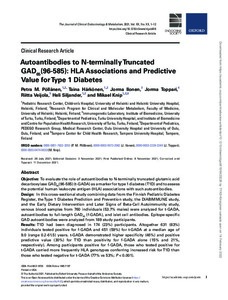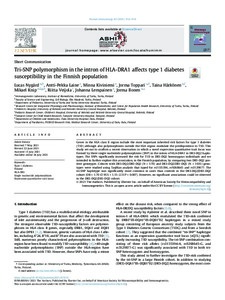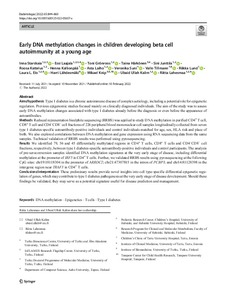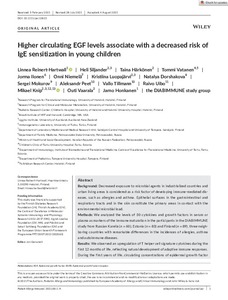Hae
Aineistot 1-6 / 6
Autoantibodies to N-Terminally Truncated GAD65(96-585): HLA Associations and Predictive Value for Type 1 Diabetes
<p><strong>Objective</strong> <br></p><p>To evaluate the role of autoantibodies to N-terminally truncated glutamic acid decarboxylase GAD<sub>65</sub>(96-585) (t-GADA) as a marker for type 1 diabetes (T1D) and to assess the potential HLA-associations with such autoantibodies.<br></p><p><strong>Design</strong><br></p><p>In this cross-sectional study combining data from the Finnish Pediatric Diabetes Register, the Type 1 Diabetes Prediction and Prevention (DIPP) Study, the DIABIMMUNE Study, and the Early Dietary Intervention and Later Signs of Beta-Cell Autoimmunity (EDIA) Study, venous blood samples from 760 individuals (53.7% males) were analyzed for t-GADA, autoantibodies to full-length GAD<sub>65</sub> (f-GADA), and islet cell antibodies. Epitope-specific GAD autoantibodies were analyzed from 189 study participants.<br></p><p><strong>Results</strong><br></p><p>T1D had been diagnosed in 174 (23%) participants. Altogether 631 (83%) individuals tested positive for f-GADA and 451 (59%) for t-GADA at a median age of 9.0 years (range 0.2-61.5). t-GADA demonstrated higher specificity (46%) and positive predictive value (30%) for T1D than positivity for f-GADA alone (15% and 21%, respectively). Among participants positive for f-GADA, those who tested positive for t-GADA carried more frequently HLA genotypes conferring increased risk for T1D than those who tested negative for t-GADA (77 vs. 53%; P<0.001).<br></p><p><strong>Conclusions</strong><br></p><p>Autoantibodies to N-terminally truncated GAD improve the screening for T1D compared to f-GADA and may facilitate the selection of participants for clinical trials. HLA class II-mediated antigen presentation of GAD(96-585)-derived or structurally similar peptides might comprise an important pathomechanism in T1D.</p>...
Tri-SNP polymorphism in the intron of HLA-DRA1 affects type 1 diabetes susceptibility in the Finnish population
<p>Genes in the HLA class II region include the most important inherited risk factors for type 1 diabetes (T1D) although also polymorphisms outside the HLA region modulate the predisposition to T1D. This study set out to ...
Early DNA methylation changes in children developing beta cell autoimmunity at a young age
<p><br></p><p>Aims/hypothesis <br></p><p>Type 1 diabetes is a chronic autoimmune disease of complex aetiology, including a potential role for epigenetic regulation. Previous epigenomic studies focused mainly on clinically ...
HLA-DR-DQ haplotypes and specificity of the initial autoantibody in islet specific autoimmunity
<p>Objective<br>We aimed to clarify the association of various HLA risk alleles with different types of autoantibodies initiating islet specific autoimmunity.</p><p>Methods<br>Follow-up cohorts from the Finnish Type 1 ...
Higher circulating EGF levels associate with a decreased risk of IgE sensitization in young children
<p>Background <br></p><p>Decreased exposure to microbial agents in industrialized countries and urban living areas is considered as a risk factor of developing immune-mediated diseases, such as allergies and asthma. ...





